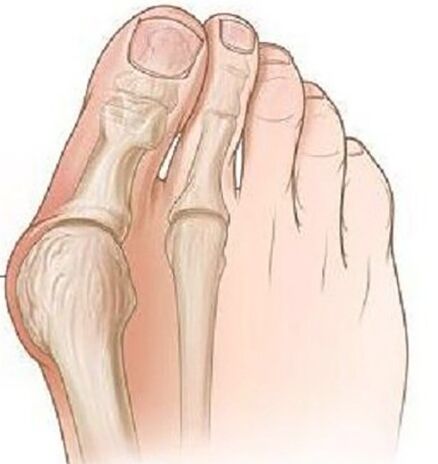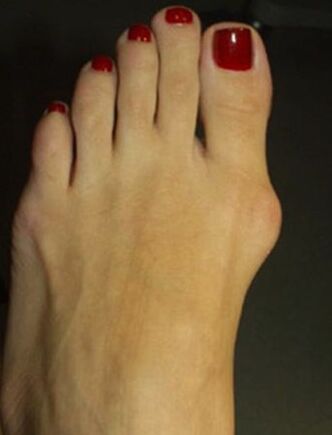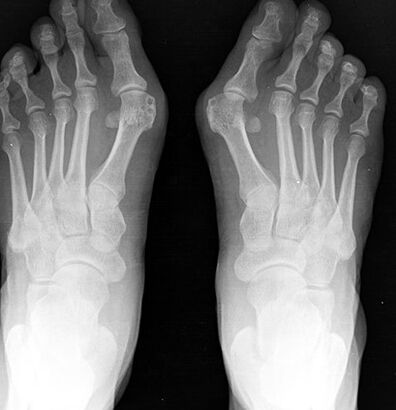The deformation of the thumb of the foot is the most frequent acquired deformation of the foot, which is characterized by the deviation of the thumb out.
The pathology is bilateral, mainly affects women over 35 years.In most cases, deformation is accompanied by chronic inflammation of the joint bag and the deforming osteoarthritis of the Plusnephalang joints, pronation deviations of the first metatarsal bone.

Causes of the disease.Why is it dangerous?
The etiological causes of the deviations of the thumb of the foot have not yet been studied completely.There are several theories of occurrence:
- Vestigial theory.In the mid -nineteenth century, it was believed that only the models were subject to this deformation due to the use of model shoes in high holes, but during the study this pathology was found in men who wore flat sole shoes.
- The theory of primary muscle weakness was refuted in a detailed study of the problem.
- The theory of the weakness of the ligament apparatus and the lack of aponeurosis of the single, most scientists adhere to this theory.
There are a number of factors that lead to the debut of this pathology:
- Excess weight increases the load on the feet.
- Distrophic changes related to age in the ligament joint apparatus.
- Weekens of Heeled Shoes has more than 5 cm, they narrow up to the foot.
- Existing skeleton deformations (scoliosis, femoral and knee joints valo deformation, flat feet).
The danger of pathology lies in the fact that over time this deformation leads to the deformation of the posture, it is possible to develop distribution depths of the spine, the hip and the knee due to the inappropriate distribution of the load during the walk, and the lesions to the muscles of the foot are accompanied by a constant pain, which significantly pushes the well -being of a person.
Clinical manifestations
At the beginning of the disease, the deformation of the valgo is not shown clinically.Most women are more concerned with the appearance of an increase in an increase in the metacarpal-phallange joint and the outbreak of the first finger becomes remarkable.

Over time, pain occurs, first when you wear narrow shoes and walking prolonged, and then the pain begins to be constant, sore.
Due to the inadequate distribution of weight, the limb, for the first and second finger in the sole, are formed by the calluses, the second finger rises, strongly widespread, the "Maleus" fingers are formed, which greatly complicates walking.Due to the deterioration of blood circulation and innervation in the anterior part of the foot, osteoarthritis and chronic bursitis are developed.
Diagnosis
- During an objective exam, the classical deformation with the deviations from the thumb is visible, the distal part of the foot expanded.In the projection of the head of the first metatarsal bone, there are signs of bursite: hyperemia and edema of the skin, pain during palpation.
- Foot radiography in two projections.The front projection determines the degree of the thumb, the status of the metacarpal-falange joint, the degree of displacement of the sesamoid bone and in the lateral projection is displayed and calculated the degree of flat feet, which often occurs with deviations of valgo of the first finger of the foot.
- PlantographyIn the printing of the foot, made of paper, a line is drawn through the center of the heel and between the fourth and third fingers, the external set of the foot is figuratively formed, according to which the presence of flattening of the foot and its degree is evaluated.In these patients, a flattened foot or flat feet of the first grade is more frequently detected.
Treatment and prevention
Depending on the seriousness of the process, a conservative or surgical treatment is carried out.
The conservative treatment is carried out in the mild stage of the disease, several types of orthopedic templates are used, which are selected individually and carry their finger deformed to the normal position, while the load in the front of the limb is stabilized and distributed.
In children's and senile age, a transverse bandage of the distal limb is used with a placement between the first and second finger.To reduce pain, warm bathrooms are used with sea salt and soft drinks, radon baths give a good result.
To combat bursitis, local anti -inflammatory gels are used, compresses with dioxide and lidocaine are used, and with pronounced pain, novocaine block and intra -articular glucocorticoid injections.

Surgical treatment is possible at any stage of the disease, it is carried out under local anesthesia, which reduces the list of contraindications for surgery.
In the first stage, the cold bone growths are eliminated on the internal edge of the bone, while it is only possible to reduce the pain of the process, but not prevent the development of deformation in the future.
With a severe deviation from the finger with the presence of flat feet, an osteotomy is carried out at the base of the bone more of the first finger using a bone blade to reject the finger to the normal position, with the help of a sink tape, the transverse ligament of the sole is formed.After surgery, the leg is well fixed with a bandage for 4 weeks, it is recommended to use individual orthopedic templates during the year.
The disease prevention is to wear comfortable shoes without high heels, shoes should sit on the leg freely, a narrow foot of the foot should not bring discomfort in the thumb.If there is any deformation of the skeleton, it is recommended to undergo preventive exams in the orthopedist to identify and slow down the progression of the deformation of the thumb of the foot.
Consequences and complications
A complication of the process is the development of Deichländer or "march" of the foot, which is characterized by acute pain, due to microcracks in the joint pairing joints and tending to vaginitis.
Due to the constant inflammatory process and mechanical damage, there is a risk of developing malignant bone neoplasms.























